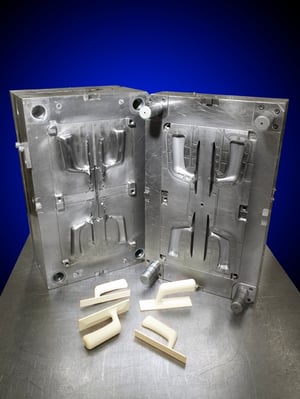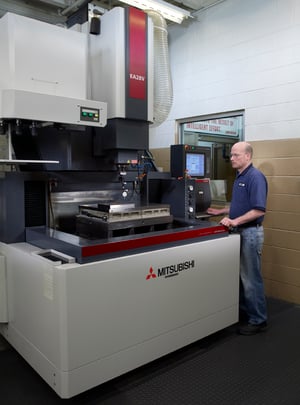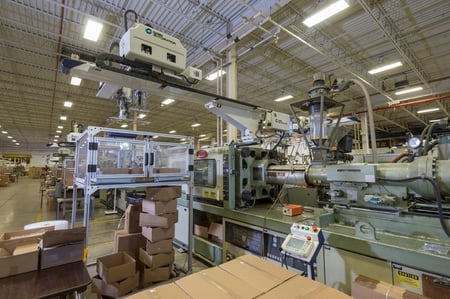As we've progressed from revolutionary inventions such as the light bulb on to the telecommunications age of the radio, phones, and televisions, the methods of manufacturing and product design have evolved as well. Computers, the internet, sustainable power, and everything that comes next is the driving force behind the advances in modern moldmaking in manufacturing. To understand where we are going, however, we must look at how we got here.
What Is Moldmaking?
Moldmaking is a process of making injection molds that are used to produce precision plastic parts. As one of the most significant production investments, it is critical that the molds are made with a great deal of accuracy. Modern plastic injection moldmaking requires extreme precision to ensure that parts can be mass-produced with repeatable accuracy. 
This perfection is also required in the creation of the tools used to manufacture, hold, or test products during production. Quality precision molds are built to last and represent an essential investment for any company. Variables that can impact the cost of the plastic injection mold include:
Core Metal
The expected length of a production operation significantly influences the material chosen for a mold. For example, some manufacturers use aluminum molds for short production runs and short-term projects and hardened steel (or a similarly durable metal) molds for long production runs and long-term projects. When selecting a material for injection moldmaking, it is important to consider whether it is more cost-effective to invest in an expensive but long-lasting mold or use a cheaper but less durable mold and replace it when worn.
Number of Cavities
Family molds allow for the production of multiple components simultaneously. However, they often produce parts of lesser quality and performance characteristics, so most molders suggest using one mold per part instead.
In regard to mold production, the number of cavities impacts the time, labor, and costs required to manufacture a mold. Generally, fewer cavities in a mold design translate to lower resources investment, while more cavities demand higher resource investment. Experienced moldmakers should be able to optimize the number of cavities to achieve the highest production efficiency at the best possible value.
Mold Base
The mold base is made of steel and designed to hold the mold cavities, inserts, and other components together. Depending on the type of steel used, customizations added, and the size of the mold, the cost of making a mold base varies.
Core/Cavity Machining
All molds are customized to meet the part and production needs of the application. Some of the mold elements that undergo customization include cavities, cores, cooling lines, and ejectors. The level of customization impacts the total cost, especially if the mold is constructed from hardened steel or other metals.
Part Complexity
The greater the complexity of the desired part, the higher the cost of the mold required. This positive relationship is because the mold design must accommodate all of the part design requirements, including in regard to surface texture and tolerance.
Learn more about these critical factors by downloading our eBook “How to Manufacturer a Perfect Plastic Part”.
What Has Changed?
Plastic injection molding first gained prominence during the 18th and 19th centuries. With the Industrial Revolution at its peak, toolmakers had to do most everything by hand. Forming tools, heat treating, sharpening, machining metal, and drilling out the design by hand required a significant time commitment. Due to the uniqueness of anything made by human hands, conformity problems often arose, and no two molds were precisely the same.
Two of the moldmaking technologies that significantly contributed to the change from manual to computer-assisted machining are:
CNC Milling Machines
CNC milling machines initially took the form of 2D Bridgeport milling machines integrated with CNC attachments. Once introduced, they changed the way manufacturers worked on parts, as they allowed for greater precision and faster processing speeds with minimal manual oversight. Today’s milling machines offer even faster speeds and accuracy for more complex molds.
CAD Programs
CAD programs have also had a significant impact on the development of the moldmaking industry by streamlining the mold design process. They allowed industry professionals to create 2D—and later 3D—renderings that could be quickly edited, tested, and modified. The French UNISURF and Sketchpad form MIT were among the first programs to revolutionize the design process, and their more advanced successors continue to find application in moldmaking operations.
The Future of Moldmaking
As manufacturing capabilities continue to advance, many industry leaders have weighed in on what’s happening and coming:
- In regard to mold demand, Bill Wood from Plastic News states: “Demand for molds can be extremely volatile, but even moderate swings in the overall totals can represent huge hardships for some shops…Some of the indicators I use to generate an outlook for the mold making sector are starting to look like they are at or very near a cyclical bottom. If this is the case, then demand for new molds could start to improve moderately in 2020.”
- When speaking about automation in an SME article, Mike Cope of Hurco Companies, Inc. expresses: “Everyone needs to get more productivity out of their machine tools, and many can’t afford to put on a second or third shift. We see companies installing pallet loaders and those types of systems and set up jobs to run automatically. When it finishes one job, the machine will get the next one. This gives them more hours of production in a day. Productivity is key.
- Discussing machine monitoring program improvements in the same article, Steve Ortner of Absolute Machine Tools Inc notes: “You can get lots of data just looking at your iPad and see how the machine is doing… Is the tool still there? If not, use a backup tool or generate an alarm to alert you on your cell phone or iPad. There are many things we can program the machine to do in order to tell you how to fix the problem.”
- Identifying 2020 trends impacting moldmakers, United Global Sourcing indicates: “One trend being seen is manufacturers’ use of durable, temperature- and corrosion-resistant materials. Makers in industries like automotive are using these types of materials—instead of steel—to increase the longevity of components and realize other benefits like lowering the weight of various parts to improve overall fuel efficiency. Furthermore, the use of bio-resins (eco-conscious plastics) continues to gain traction in the plastic injection molding arena since they have a lower impact on the environment than oil or petroleum-based resin without sacrificing their usability. Finally, technology has now evolved that allows plastic makers to mold metals, ceramics, and carbides—in addition to plastics.”
Expanding on the last point, some industries are turning to alternatives for part manufacturing. For example, general goods manufacturers are experimenting with bio-resins instead of plastics, while other sectors (e.g., aerospace and automotive) are adopting the use of plastic composites—i.e., plastics imbued with glass, aramid, or carbon fiber fillers that add strength and structural integrity. Among other advantages, these material alternatives may allow for lighter part weight and lower production costs.
Not only is the chemical technology behind plastic alternatives improving, but it’s also quickly becoming a necessity. With the implementation of China’s ban on imports of solid wastes as raw materials. —i.e., the National Sword policy—companies need to create responsible recycling plans.
Working with Rodon
The Rodon Group fabricates industry leading manufacturing, and our warranty only serves to reinforce our claim. Our molds are crafted from stainless steel and built to outlast high-volume, high-tolerance production. We guarantee the best in performance and durability for the lifetime of your tool.
Our designers and moldmakers combine their talent and experience to produce molds that deliver quality parts with precision tolerances and improved cycle times. Our facility has 118 presses, fully automated and with a full production schedule – 24 hours, 7 days a week – during most of the year to maximize efficiency. 
Rodon provides innovative manufacturing solutions that include mold design, mold building, and high-volume parts manufacturing. We are world renowned for the production of injection molded components of the highest quality and precision at highly competitive prices. From concept to completion, we provide all of the necessary resources to promptly and accurately complete your project. We serve industries ranging from consumer products and construction to windows and doors, medical and pharmaceutical, and food and beverage.
To learn more about our manufacturing capabilities and discover what makes us different, please visit our website. If you're ready to jump into your next project with us, request a quote here. No matter your need, contact us today so we can help your business face all of the changes and challenges of today's competitive marketplace.









Comments